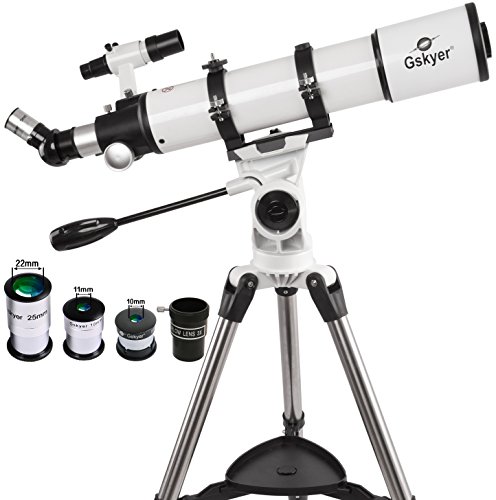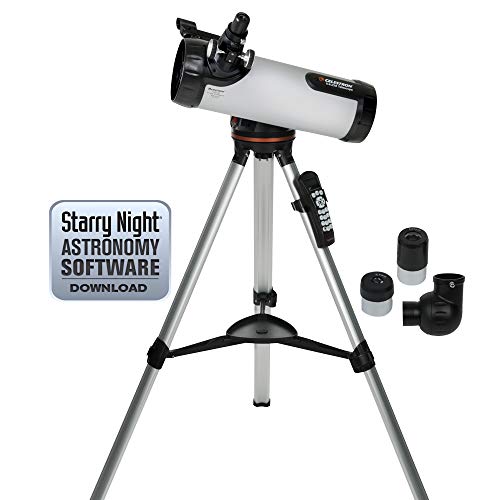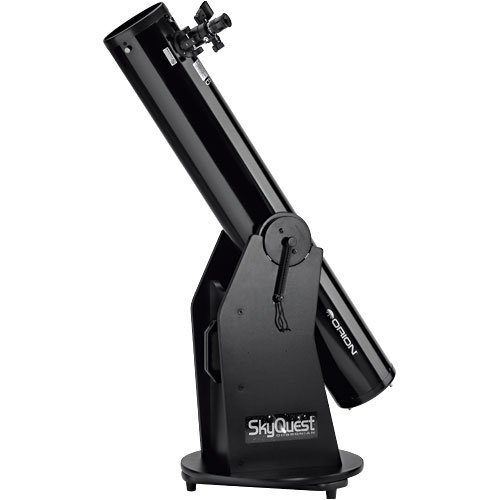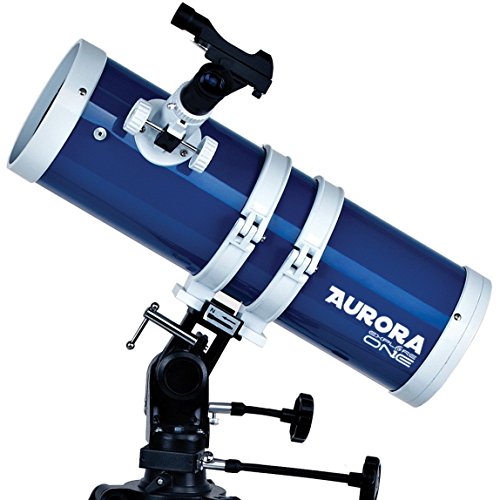5 Best Telescopes Under $300 of 2024 – Reviews & Buyer’s Guide
Last Updated on

Humans have long looked up at the stars and wished they could get a better view. Inexpensive telescopes and online shopping have made that quest far easier, in theory. In practice, there’s a deluge of products, prices, and features that can make buying a telescope make heading to space seem easy.
You don’t want to sort through dozens of models to find the one that’s right for you. Instead of doing that, check out this list of the best telescopes under $300. Our reviews tell you the things you really need to know about each model, good and bad so that you can find one that meets your needs while avoiding problems.
We’ve also got a buyer’s guide. If you want to learn more about telescopes before you buy, or just want to make sure you’re getting good value for your money, be sure to check it out.
A Comparison of Our Favorite Models in 2024:
| Image | Product | Details | ||
|---|---|---|---|---|
| Best Overall |
 |
Gskyer AZ90600 |
|
CHECK PRICE |
 |
Celestron 114LCM |
|
CHECK PRICE | |
| Best Value |
 |
Celestron AstroMaster 70AZ |
|
CHECK PRICE |
 |
Orion SkyQuest XT6 |
|
CHECK PRICE | |
 |
ExploreOne B07DG3292D |
|
CHECK PRICE |
The 5 Best Telescopes under $300:
1. Gskyer Refractor Telescope AZ90600 – Best Overall
The Gskyer Refractor Telescope AZ90600 is one of the best telescopes you can find for under $300. It comes with a large, 90-millimeter lens, which allows bright images of the night sky and exceptional detail and color during the day. The 24x, 60x, and 120x eyepieces give you a wide range of viewing options and make this telescope great for seeing detail on the moon, or for spotting distant planets like Jupiter. Also included is a stainless steel tripod, which is very durable, and folds down so you can travel easily with this telescope.
It also provides excellent overall image quality. You can’t always expect great detail from inexpensive telescopes, but this model performs on a level that would suggest a much higher price tag. The only frequent consumer complaint relates to the instructions. They aren’t as clear as they could be, and that sometimes leads to longer assembly times. If those were to be fixed, we’d have no complaints about this model. If you’re looking for a high-performing telescope on a budget, you’ll like this one.
- Large lens
- Includes three eyepieces
- Stainless steel tripod
- Great image quality
- Tricky assembly
2. Celestron 114LCM Computerized Telescope
The Celestron 114LCM Computerized Telescope is a better overall choice for the semi-serious stargazer. This telescope comes with a very large, 114-millimeter lens, which captures a ton of light and helps you make out faint stars, even in areas with bad light pollution. It’s also computerized. This means you can align it with the moon or a few prominent stars, and it’ll calculate where 4,000 other objects in the night sky will be and automatically orient the telescope to spot them. It has two lenses with 60x and 167x magnification, so you’ll be able to get great images of the moon and of distant planets and stars.
This model also excels when it comes to color distortion. Some telescopes have red-shifting or blue-shifting issues. This telescope is about as close to dead-on as you could hope for. The only downside is that it uses eight AA batteries at once, and you only get five hours of use from those batteries. However, if you want to experience the stars without having to figure out where they are yourself, you’ll really like what this model has to offer.
- Very large lens
- Computerized telescope
- Two eyepieces
- Minimal color distortion
- Burns through batteries quickly
3. Celestron AstroMaster 70AZ Refractor Telescope – Best Value
The Celestron AstroMaster 70AZ Refractor Telescope has a lot of value at a price that won’t break the bank. This model has an Alt-Az control with a clutch. That allows smooth and easy pointing, so you can easily zero in on the star or planet you want to view. It’s also easy to assemble, as it doesn’t require any tools, and uses simple connections to get the job done. It has two eyepieces, so you can view the sky at either 45x or 90x magnification.
However, the best thing is the price. You can get it for about 40 percent of what you’d have to pay to get the top two models on this list. That makes it the best overall value for the money here. Unfortunately, the tripod tends to be shaky, and sometimes shifts while in use. If you’re looking for a great telescope, you’ll still like this one, despite the underwhelming tripod.
- Smooth pointing
- Easy setup
- Two eyepieces
- Great price
- Shaky tripod
4. Orion SkyQuest XT6 Dobsonian Telescope
The Orion SkyQuest XT6 Dobsonian Telescope is a mid-grade telescope with many frills stripped out so you can get it for a beginner-grade price. It has a massive six-inch lens. That’s more than 150 millimeters in diameter, which makes it the largest lens by far on our list. Because of that, it’s a great model for viewing other planets in our solar system. You can make out the polar caps on Mars, Saturn’s rings, and even some of Jupiter’s moons. This model also comes with a great base which makes it easy to reposition, but also nearly completely eliminates vibrations for a steady image. When it comes to the image quality you’re getting, this is easily the best model we reviewed.
However, we also look at value when we make our rankings. This is the most expensive model we looked at, and it lacks any secondary features that make some of the others great value. It also comes with just one lens, so you may need to invest in an expensive lens set to use this telescope to its full potential, which hurts its overall value.
- Great for planet viewing
- Excellent base
- Very large lens
- Expensive
- Only one lens
5. ExploreOne B07DG3292D Reflector Telescope
The ExploreOne B07DG3292D Reflector Telescope is an inexpensive telescope with some upsides. It does come with a large, 114-millimeter lens. That’s bigger than you’d expect for the price and lets a lot of light into this telescope. There’s also a pair of lenses that give you 20x and 52x magnification, which is okay, but not as good as what you get from some of the others here. It also has a flimsy tripod, which can make it hard to focus on any objects smaller than the moon.
This telescope is one of the more expensive ones ExploreOne makes, and that means it’s the best of a cheap bunch. It’s not a company with outstanding optical quality, or that clearly invests a lot of care in design and manufacturing. That means this telescope is best as a starter model, since it’s limited in what it can do. Given its price, it makes sense to invest a little more and get a telescope with more flexibility and better overall quality.
- Large lens
- Two eyepieces
- Flimsy tripod
- Best of an underwhelming line
- Starter telescope
Buyer’s Guide – Choosing the Best Telescope Under $300
Aperture
The biggest distinguishing feature between telescopes at a given price point is the aperture size. The aperture is the hole in the front of the telescope in which the lens sits, and the diameter of that lens will be equal to the aperture size. The lens is sometimes called the “objective,” so the measurement of the lens diameter, the objective, or the aperture will be the same on a given telescope.
The bigger the aperture, the more light the telescope lets in. More light means you can get more detail at the same magnification, and that you can increase the magnification without losing too much detail. It also means you’ll be able to see more distant objects. If you want to look at other planets in our solar system, such as Mars, Saturn, or Jupiter, you’ll probably want a telescope with at least a 100-millimeter lens. Anything smaller may not be up to the task.
Of course, moving to a dark area increases what you can see with your telescope. In an area sufficiently free from light pollution, you can make out other galaxies with just an 80-millimeter aperture telescope. In a neighborhood or city, that increases to somewhere in the 120- to 150-millimeter range.
Keep in mind that the maximum useful magnification scales with aperture size. Generally, this is around 50 times the aperture size, so an 80-millimeter telescope would have a maximum magnification of 400x in optimal viewing conditions.
Telescope types
There are three primary types of telescopes:
Refractor
When most people think of a telescope, the refractor type is what’s going to pop into their minds. This kind of telescope uses a lens to focus light on a single mirror, which is angled to direct the light through an eyepiece into your eye.
They’re very simple, so they don’t require much maintenance. While a lot of beginner telescopes use this design, they get exponentially more expensive as the aperture size increases. If you want a large aperture telescope right off the bat, you may get better value from a different model.
Reflector
Reflector telescopes feature a clear piece of glass or plastic at the front of the tube. These don’t warp the light, so they aren’t lenses, but instead a protective shell to keep dust out. A mirror sits at the back of the tube. It’s curved to focus light on a second mirror, which directs light through the eyepiece and to your eye.
Reflector telescopes are easily identified by the fact that the eyepiece is found near the telescope’s front. These tend to be the least expensive, and you can get larger apertures for a lower price than with other models. The one downside to reflector telescopes is that they must be calibrated regularly in a process called “collimation.”
Compound
Compound telescopes use an initial lens to focus light onto a mirror at the back of the telescope. The mirror focuses light onto a smaller mirror mounted on the back of the lens, which directs light through a tube that runs through the center of the first mirror and out the back of the telescope.
Compound telescopes are very lightweight relative to other types, and they don’t require collimation like reflector telescopes do.
Mount type
There are three common mount types that can dramatically change your experience with a telescope.
The altitude-azimuth, or “alt-az,” mount allows you to move the telescope up and down and turn it clockwise or counterclockwise around the tripod.
Modern reflector telescopes often have a Dobsonian mount. While this mount may look simple from the outside, it’s designed to reduce stress on the internal components. That means thinner, less expensive parts can be used to achieve the same effect, and it’s a big part of why reflectors are now among the most affordable telescopes relative to aperture size.
Equatorial mounts have an axis of rotation that allows you to turn a telescope to track a celestial object. This is useful when taking long-exposure photographs of objects in the night sky, though it requires careful calibration and operation to produce the desired effect.
Computer features
Some telescopes come with computerized star tracking. Once you calibrate them, they’ll automatically realign themselves with the objects you input. Most models support thousands of objects, so you’ll be able to use your telescope to its full extent, even if you’ve never identified the stars, planets, or galaxies in question before.
Computerized telescopes are great for beginner or amateur astronomers. They’re also a good resource for getting children into astronomy, even if you have no relevant experience.
However, they require careful calibration to work correctly. If you live in a light-polluted area, you may not be able to clearly see the stars you need to find to calibrate the telescope.
They also consume a lot of power. Some models run on batteries, and they tend to burn through them quickly. That leads to a high cost of operation, though some models allow you to mitigate it with the purchase of an AC adapter.
Which telescope is right for you?
The telescopes we reviewed have differences in type, mount, and aperture size, but the one thing they have in common is that they’re all good for beginners.
To find the best telescope under $300 that meets your needs, focus on your individual requirements. Determine what objects you’d like to see in space, and what kind of telescope provides the best chances of clear images of those objects. Consider whether you’re going to do any photography or will be able to make use of a computerized system.
Look for models with matching features, then get the lowest-priced model. It has what you need for a good experience, at the best price.

Conclusion:
The Gskyer Refractor Telescope AZ90600 is the best telescope under $300 overall choice here due to its large lens, three eyepieces, and stainless steel tripod. The Celestron 114LCM Computerized Telescope comes with a very large lens and two eyepieces, plus it’s computerized, making it great for beginning astronomers. The Celestron AstroMaster 70AZ Refractor Telescope has smooth pointing, easy setup, and two eyepieces, and its very low price makes it the best value for the money here. The Orion SkyQuest XT6 Dobsonian Telescope is great for planet viewing and has a quality base, though its high price and inclusion of just one lens drop it to fourth place. The last place goes to the ExploreOne B07DG3292D Reflector Telescope. It has a large lens and two eyepieces, but its low overall quality means you can get better value for the money.
Decided that you have a bigger budget? We’ve also created a top 5 of telescopes that cost under $500.
About the Author Robert Sparks
Robert’s obsession with all things optical started early in life, when his optician father would bring home prototypes for Robert to play with. Nowadays, Robert is dedicated to helping others find the right optics for their needs. His hobbies include astronomy, astrophysics, and model building. Originally from Newark, NJ, he resides in Santa Fe, New Mexico, where the nighttime skies are filled with glittering stars.
Related Articles:
Holy Stone Drone Review of 2024 – Pros, Cons, and Verdict
Ultraviolet Light vs Black Light: What’s the Difference?
Light Waves vs. Sound Waves: How Are They Different?
Infrared vs. Thermal Cameras: How Are They Different?
Far Infrared vs Near Infrared: What’s The Difference?
Mottled Duck vs. Mallard vs. Black Duck: What’s the Difference?
Shutter Speed vs Frame Rate: Pros, Cons, & Difference
Oriole vs Goldfinch: How to Tell the Difference








